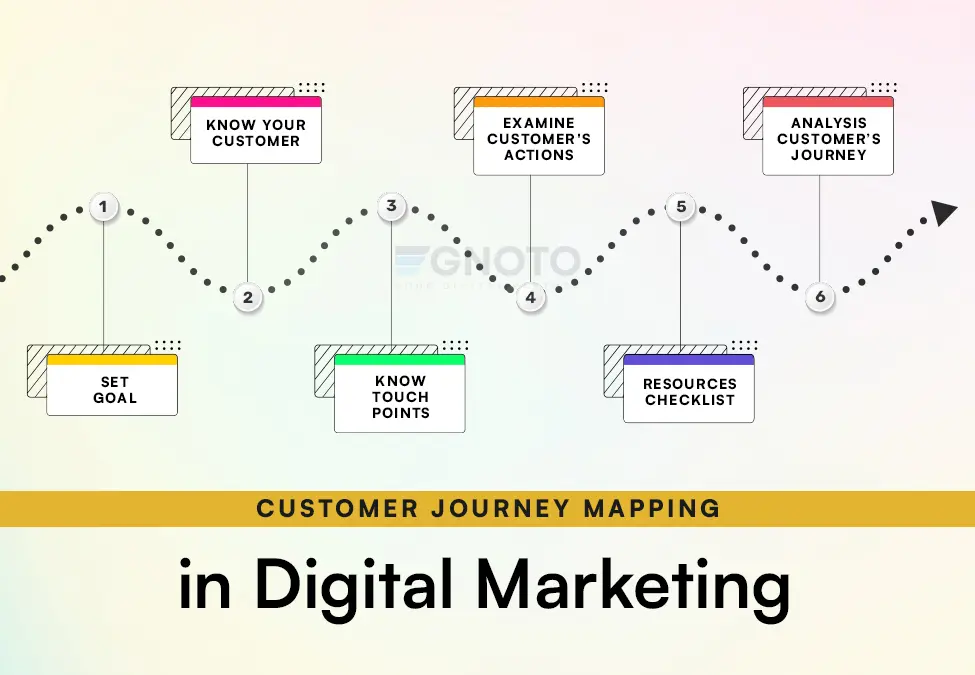Who doesn’t want to be a unicorn in the field of horses? However, to become a successful business, you must have a customer-centric approach. And one of the best ways to do it is via a digital marketing tool that creates a visual map of a customer’s journey. What is it, and how does it work? Let’s get into the nitty-gritty of the topic.
The Customer Journey Map: What Is It?
Wondering what it is? A customer journey map is a visual sketch of the various stages a customer has to go through when interacting with a company, from searching to buying items online, interacting with customer service, and receiving feedback on social media.
This map helps a business see from a customer’s perspective. It tells how a customer actually experiences your brand vs. how you think they do. It is crucial for a business to truly understand a customer’s storyline to give the best experience.
Note: When you empathize with customers’ needs and concerns, you can work towards achieving the outcomes that are most important to them.
Its Benefits: How Does It Add Value To Your Business?
Better User Experience
When you study the customer’s side of the story, you can isolate points where you are not able to meet their expectations. You also learn if you are alienating any customer base. By noticing and working on drawbacks, a business can provide a better customer experience and increase customers’ interaction right from the start (searching for a product) to the end (buying the product).
Help Customers Achieve Their Objectives
Jeff Bezos has said, “We are not competitor obsessed; we are customer obsessed. We start with what the customer needs, and we work backward.” As a business, your primary focus must be on your customers’ success. To ensure this, you can create, adjust, and modify touchpoints. This makes the entire buying process effective and efficient.
Note: When customers achieve their goal from pre-purchase to post-purchase, they will likely return and recommend your services to others.
Help Business Understand Customer Behavior
As a company, you must understand the customer’s context. If you don’t understand the customer journey, you don’t understand them as well, which can hinder your ability to target the right audience group to sell products. Nowadays, many businesses deliver extremely personalized experiences, and a shallow understanding serves little.
A customer journey map is a digital marketing technique that helps to gain valuable insights and identify existing and future customers. This map gives a complete and big picture of the current scenario so that you can get better returns on your marketing and invest in areas that create engagement.
Optimize Marketing & Its Effectiveness
A customer journey stage helps you find the most effective marketing methods that you can deploy to get better results. You can learn which marketing methods are producing results and converting into more leads and which ones are underperforming or not working at all.
With this information, you can optimize your marketing strategies to get the most leads and better results. You can use performance metrics such as impressions, click-through rates, conversion rates, referrals, repeat purchases, etc., to identify the gaps to be filled and touchpoints that must be addressed to improve overall customer experience. These gaps can be between devices, departments, channels, and managerial sections.
How To Create A Customer Journey Map?
1. Set Goal
Create a buyer’s persona to know who you are making this map for and why you are doing it. It helps with the following:
- Defining end-user goals
- Creating needs and topics that interest them
- The greater the amount of details, the better will be the persona
Now, you will need a large amount of marketing details to get the data mentioned above. Start with the buyer’s demographic, such as their age, gender, profession, education, income, and location. Once you get this data, you can create psychographic data on the client. It includes information on customer’s personality traits, interests, likes, dislikes, and attitudes.
Though it may be harder to collect, it is worth it to understand the customer’s preferences, wishes, wants, and needs. So, demographics show you who your customers are, and psychographics tell you about their behavior.
2. Know Your Customer
Who do you want to pitch your products and services to? Know your target audience by analyzing their first interaction and map out every movement from there. Learn what they are looking for, their priority, and their expectations and goals.
By learning what the persona is trying to do and what the end goal is, you can optimize your service to meet their expectations. When you know what a persona needs, you spend less on marketing or educating the market.
Note: Remember, the persona is trying to achieve their own goals and not seeking for your services. So, you must walk into customer’s shoes to understand their perspective and design your digital marketing strategies accordingly.
3. Know Touchpoints
A touch point is any instance when a customer tries interacting with a system, interface, or other means. It can be both internal and external.
- Internal touchpoints: These can be emails, newsletters, meetings, the website’s landing page, etc.
- External touchpoints: These can be interactions with products or services, or contact with the physical world, such as display ads, social media ads, video ads, and events.
Customers’ interaction with your brand, either directly or indirectly, gives collective information about their journey and influences customer experience. These touch points can be before, during, or after a purchase and can tell you how a customer perceives your product and what impact it can have on their decision-making.
4. Examine Customer’s Actions
Identify some of the common actions that customers take at each step, whether interacting or buying. When you divide each stage of a customer’s journey into an engagement, you move them along the sales funnel.
For instance, you can monitor how many steps a user needs to make when trying to make a purchase and reduce the number of steps involved so that customer reaches their goal sooner. One way to do this is by identifying the pain points and removing them.
Some of the most typical pain points are as follows:
- Process pain points: not able to find items online, app loading slow, difficulty navigating, etc.
- Support pain points: poor customer service, complicated return policy, etc.
- Productivity pain point: unable to use the product, damaged items, etc.
- Financial pain point: The product is not worth the price, hidden fees, frequent replacements, expensive memberships, etc.
But how can you recognize customers’ pain points? You can learn by asking questions directly or by regularly updating your customer service team about the most common problems. That way, you can eliminate them and improve the buyer’s journey.
5. Resources Checklist
Ensure you have adequate resources to create a customer journey map. Some commonly used tools for this in digital marketing are Excel & Google Sheets (basics), or you can use a template such as HubSpot’s Customer Journey Map Template for advanced-level mapping.
Know if the available resources are enough for a seamless transit for a customer’s experience. This will help you determine how existing resources can be allocated and what new resources are needed. All this will directly affect your sales and ROI. You can add some extra tools to enhance your customer service.
Some mapping components involve identifying key stages such as awareness, purchase, post-purchase, etc., listing touch points for each of these stages, understanding customers’ emotions during each stage, and learning about challenges faced by customers and what they are trying to achieve. But how do we do it? Let’s see.
6. Analysis Customer’s Journey
You can keep a visual, precise, and concise record that is easy to understand. You may need to collaborate with different teams within your company to gain insight. Also, this map needs to be updated on a regular basis, and new insights as they arrive.
By analyzing this map, you can identify areas that are not fulfilling customers’ needs and find solutions to them. You can also take a journey yourself to see if anything is missing or if you can improve something.
Bonus: Take Planned Action
When you have a clear view of a customer’s journey from start to end, you can continuously make changes and adjust your plans to align with the customer and your vision. Making changes while keeping customers’ pain points in mind makes the entire process seamless, and you get better engagement.
Most opportunities will arrive from a combination of action and emotions. Failure to recognize a potential pain point at one stage can translate into customer loss. Now that we have discussed most of the parts related to the user journey, we hope you will be able to make informed decisions for your business.
Get A Comprehensive View Of Customer Journey From Egnoto Team
Connect with various channels and find out the context behind each customer’s action. Get ahead of everyone else in your digital marketing game. From mapping pre-purchase to post-purchase of a user, you can now create the best solution to tackle the issue for each stage.










